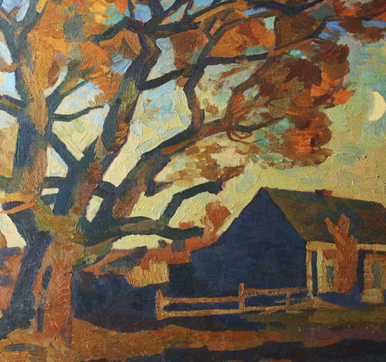In the painting ‘Portrait of E.Sh.’ (the second name is ‘Portrait of My Wife’) from the Volzhsk Art Gallery collection, Gennady Myznikov depicted his wife — a young dark-haired woman with a short haircut. She is dressed in a red blouse, which contrasts with the light uneven background. Unfortunately, the woman’s name has not been preserved.
Myznikov prefers pure, bright colors and their contrasting juxtapositions. His painting style, which is distinguished by the warm light in the space of the picture, resembles the transparency and softness of paintings on porcelain.
In his career, Gennady Myznikov achieved the greatest success in portraiture. While in his early works he sought to convey the general emotional state of his models and the main features of their appearance, in later portraits he elaborated the individual characteristics of the portrayed.
Gennady Myznikov was born on March 12, 1933, in the old industrial town of Orekhovo-Zuevo in a worker’s family. In 1950, he graduated from the Likino-Dulyovo Art and Craft College with a degree in porcelain art. After that, he studied at the faculty of monumental painting at Leningrad Higher Art and Industrial School named after Vera Mukhina. However, Myznikov was mainly engaged in easel painting. His career was successful: he became a member of the Union of Artists of the USSR in 1961.
Myznikov’s artistic search began in the 1960s. It was an important stage of Soviet painting: a large group of young artists, representatives of the austere style, appeared. This was the name of the movement in Soviet realistic painting, showing the “heroics of everyday work of ordinary Soviet people.”
Like other “austere” painters, Myznikov saw the artist’s task in the struggle for truth in the depiction of life as opposed to sentimental bourgeois art. He painted highly social genre works devoted to the life and character of the Russian province. But by the time the ‘Portrait of E. Sh.’ was created, his paintings had become more complex and intimate, which was typical for many artists of the sixties in the late 1970s. Many painters, including Myznikov, switched from social themes to more neutral landscapes, still lifes, and portraits.
In 1991, Myznikov received the title of Merited Artist of the RSFSR, and in 2005, he became a People’s Artist of the Russian Federation. The artist died in 2018.
Myznikov prefers pure, bright colors and their contrasting juxtapositions. His painting style, which is distinguished by the warm light in the space of the picture, resembles the transparency and softness of paintings on porcelain.
In his career, Gennady Myznikov achieved the greatest success in portraiture. While in his early works he sought to convey the general emotional state of his models and the main features of their appearance, in later portraits he elaborated the individual characteristics of the portrayed.
Gennady Myznikov was born on March 12, 1933, in the old industrial town of Orekhovo-Zuevo in a worker’s family. In 1950, he graduated from the Likino-Dulyovo Art and Craft College with a degree in porcelain art. After that, he studied at the faculty of monumental painting at Leningrad Higher Art and Industrial School named after Vera Mukhina. However, Myznikov was mainly engaged in easel painting. His career was successful: he became a member of the Union of Artists of the USSR in 1961.
Myznikov’s artistic search began in the 1960s. It was an important stage of Soviet painting: a large group of young artists, representatives of the austere style, appeared. This was the name of the movement in Soviet realistic painting, showing the “heroics of everyday work of ordinary Soviet people.”
Like other “austere” painters, Myznikov saw the artist’s task in the struggle for truth in the depiction of life as opposed to sentimental bourgeois art. He painted highly social genre works devoted to the life and character of the Russian province. But by the time the ‘Portrait of E. Sh.’ was created, his paintings had become more complex and intimate, which was typical for many artists of the sixties in the late 1970s. Many painters, including Myznikov, switched from social themes to more neutral landscapes, still lifes, and portraits.
In 1991, Myznikov received the title of Merited Artist of the RSFSR, and in 2005, he became a People’s Artist of the Russian Federation. The artist died in 2018.



